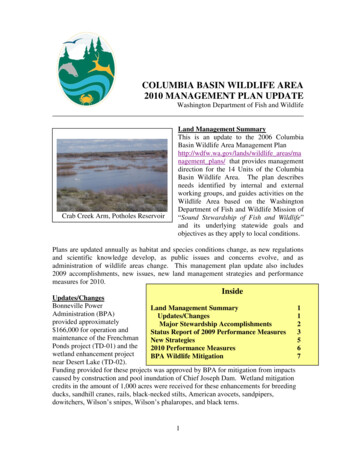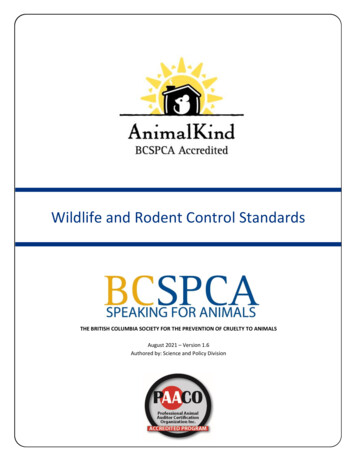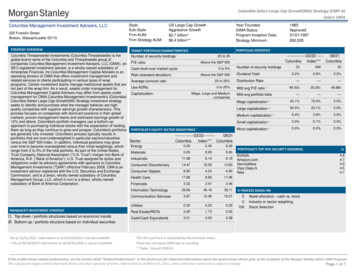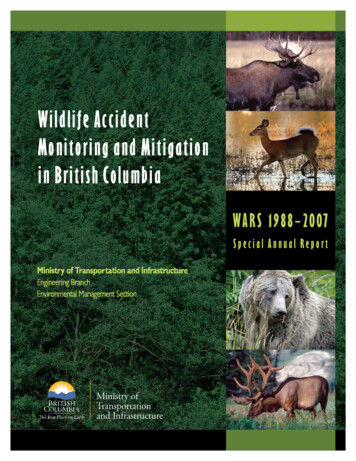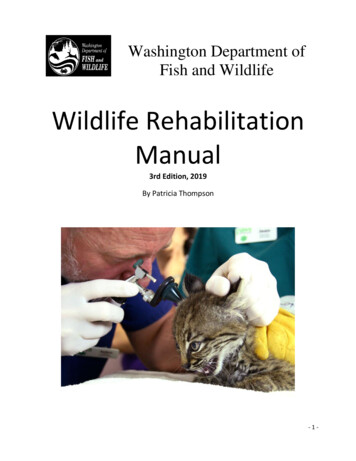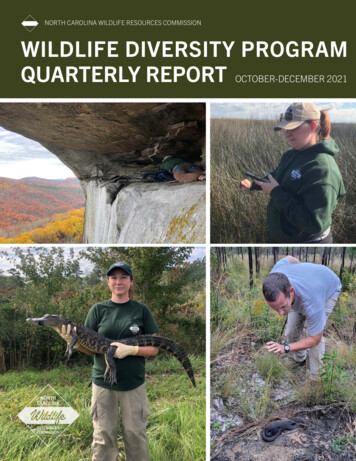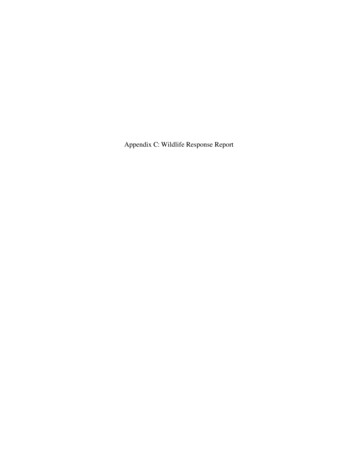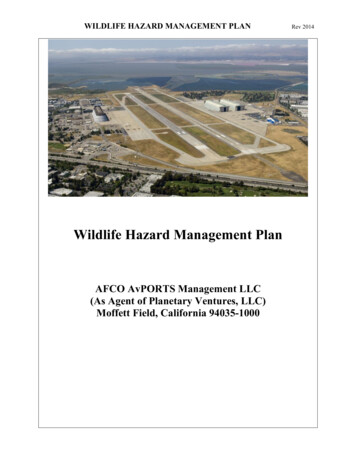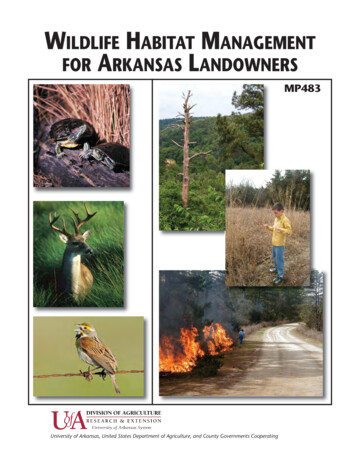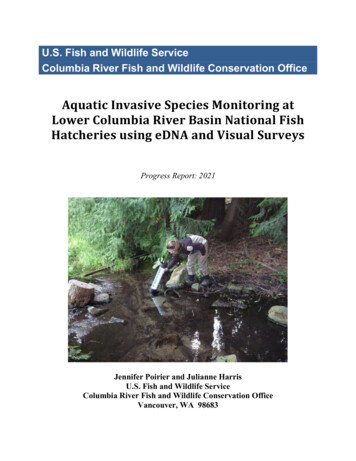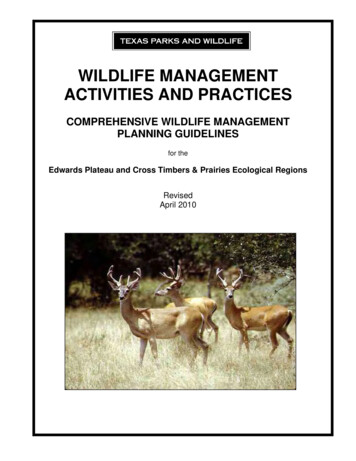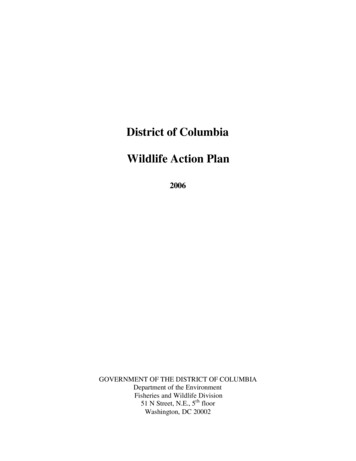
Transcription
District of ColumbiaWildlife Action Plan2006GOVERNMENT OF THE DISTRICT OF COLUMBIADepartment of the EnvironmentFisheries and Wildlife Division51 N Street, N.E., 5th floorWashington, DC 20002
DISTRICT OF C OLUMBIA ’S W ILDLIFE ACTION P L A NPrepared by Mary Pfaffko, Wildlife Biologist and the Internal Group of the Fisheries andWildlife Division, under the supervision of Ira Palmer, Program Manager (1987-2005)Fisheries and Wildlife Division.2
DISTRICT OF C OLUMBIA ’S W ILDLIFE ACTION P L A NTable of ContentsAcknowledgments. 7Executive Summary . 8Introduction. 9Goals, Approach & Value . 9Legislative Mandate and Guidance . 10Background on the DC Fisheries and Wildlife Division. 14Problem and Need. 15Threats . 16Conservation Legislation and Partners . 17Existing Conservation Legislation. 17Key Conservation Partners. 18Overview . 21Organization and Format of the Wildlife Action Plan (WAP) . 21Roadmap to the 8 Required Elements. 23Chapter 1 – Approach. 28Timeline . 28WAP Development Process. 30Roles and Groups. 30Public Involvement Summary . 32Educators and Students . 32Conservation NGOs . 32General Public. 32Selecting and Ranking Species. 33Selection Criteria . 33Prioritization Process . 34Selecting and Ranking Habitats . 35Selecting and Ranking Threats . 36Programmatic Challenges. 36Chapter 2 – District Overview. 38Ecoregions . 38Land Use . 42Regional Context . 43Chapter 3 – Species of Greatest Conservation Need and their Habitats . 443
DISTRICT OF C OLUMBIA ’S W ILDLIFE ACTION P L A NSpecies of Greatest Conservation Need. 44Birds. 45Mammals. 46Reptiles. 46Amphibians . 47Fish. 47Invertebrates. 48Status and Trend. 49Habitat Types and Conditions . 55Terrestrial Habitats. 58Aquatic Habitats. 61Priority Habitat Locations . 67Terrestrial Habitats. 67Aquatic Habitats. 68Chapter 4 - Threats. 70Threat Prioritization. 70National, International and Global Threats . 70Global. 70International . 71National. 71Threat Tables. 71The Top Five Threats . 75Terrestrial Habitats. 75Aquatic Habitats. 76Additional Threats Prioritized. 77Terrestrial. 77Aquatic . 79Chapter 5 – Conservation Actions – Habitats. 81Overarching Actions . 81Conservation Actions by Habitat . 83Habitat 1 – Rivers and Streams. 85Habitat 2 – Hardwood Forests . 89Habitat 3 – Emergent Non-tidal Wetlands . 93Habitat 4 – Grasslands/Managed Meadows. 96Habitat 5 – Forested Wetlands / Riparian Woodlands / Floodplains . 100Habitat 6 – Early Successional / Shrub-Scrub / Edge . 104Habitat 7 – Emergent Tidal Wetlands. 107Habitat 8 – Urban Landscape. 110Habitat 9 – Tidal Mudflats. 113Habitat 10 – Springs and Seeps . 116Habitat 11 – Submerged Aquatic Vegetation . 120Habitat 12 – Vernal Pools . 1234
DISTRICT OF C OLUMBIA ’S W ILDLIFE ACTION P L A NHabitat 13 – Ponds and Pools . 126Chapter 6 – Conservation Actions – Species. 129Birds of Greatest Conservation Need. 129Mammals of Greatest Conservation Need. 172Reptiles of Greatest Conservation Need. 184Amphibians of Greatest Conservation Need. 208Fish of Greatest Conservation Need. 225Invertebrates of Greatest Conservation Need. 240Chapter 7 – Public Outreach and Participation. 247About The Branch. 247Branch Mission. 247Existing Programs . 247Existing Goals . 249WAP Goal . 250Key Objectives and Strategies for the WAP Goal: . 250Chapter 8 – Monitoring, Review and Revision. 252Approach to Monitoring. 252Monitoring Species of Greatest Conservation Need. 252Monitoring Need . 254Monitoring Projects . 254Birds. 254Mammals. 257Reptiles. 258Amphibians . 259Fish. 260Invertebrates. 262Monitoring Conservation Actions . 263Performance Indicators and Criteria . 264Multi- level Monitoring . 264Adaptive Management of Conservation Actions . 266Review and Revision. 266Literature Cited . 268Appendix 1 – Scoring Process for Candidate Species of Greatest Conservation Need273Appendix 2 – Species Grouped by Habitat. 288Appendix 3 – Threat Ranking to Habitats. 303Appendix 4—Key Meetings in the Development of the WAP . 314Appendix 5 – References for Species Fact Sheets. 3185
DISTRICT OF C OLUMBIA ’S W ILDLIFE ACTION P L A NList of FiguresFigure 2.1 Physiographic Area 10 (Source: PIF) .39Figure 2.2 Physiographic Area 44 (Source: PIF) .40Figure 2.3 TNC Ecoregion System (Source: TNC).41Figure 2.4 North American Bird Conservation Initiative Bird Conservation Regions (Source:NABCI) .41Figure 2.5 Land Use Map of DC (Source: DC Office of Planning 2006).42Figure 3.1 Priority Habitat Types for the District of Columbia.57Figure 5.1 WAP Habitat Map: Rivers and Streams .85Figure 5.2 WAP Habitat Map: Hardwood Forests .89Figure 5.3 WAP Habitat Map: Emergent Non-tidal Wetlands .93Figure 5.4 WAP Habitat Map: Grasslands/Managed Meadows .96Figure 5.5 WAP Habitat Map: Forested Wetlands/Riparian Woodlands/Floodplains. 100Figure 5.6 WAP Habitat Map: Early Successional/Shrub-Scrub/Edge . 104Figure 5.7 WAP Habitat Map: Emergent Tidal Wetlands . 107Figure 5.8 WAP Habitat Map: Urban Landscape . 110Figure 5.9 WAP Habitat Map: Tidal Mudflats . 113Figure 5.10 WAP Habitat Map: Springs and Seeps . 116Figure 5.11 WAP Habitat Map: Submerged Aquatic Vegetation . 120Figure 5.12 WAP Habitat Map: Vernal Pools . 123Figure 5.13 WAP Habitat Map: Ponds and Pools . 126List of TablesTable 1. Timeline used to meet the 8 Required Elements.29Table 2. Working Group Participants and their Affiliations .31Table 3. Level of Public Involvement in the Development of the WAP.32Table 4. Summary Statistics of the District’s Wildlife Species, by Taxa.45Table 5. Species of Greatest Conservation Need.45Table 6. Status and trend of Species of Greatest Conservation Need.50Table 7. Priority Habitat Types .55Table 8. Status and Trend of Habitat Types .56Table 9. Habitat Types Prioritized.56Table 10. Threats to Terrestrial Habitats .72Table 11. Threats to Aquatic Habitats.736
DISTRICT OF C OLUMBIA ’S W ILDLIFE ACTION P L A NAcknowledgmentsThe District of Columbia's Fisheries and Wildlife Division would like to acknowledgeand thank all of the individuals, groups, agencies and organizations that contributed to thedevelopment and writing of the District of Columbia’s Wildlife Action Plan (WAP).The Internal Group, composed of key staff from the District's Fisheries and WildlifeDivision, included Basil Buchanan, Michael Kaspar, Dhananjaya Katju, Ira Palmer, MaryPfaffko, Jon Siemien, and Sylvia Whitworth. In addition to being very small, theFisheries and Wildlife Division has only been officially managing the District's wildliferesources for less than five years. In this short period of time, the staff has learned atremendous amount about the District’s wildlife resources, which has helped in thedevelopment of this WAP. The staff’s dedication and hard work has made the differencein what seemed like an enormous task for such a young organization as the Fisheries andWildlife Division. My deep appreciation and thanks goes out for a job well done.Special thanks go to Mary Pfaffko, a Wildlife Biologist with the District’s Fisheries andWildlife Division, who did a yeoman’s work in leading the effort to write the WAP andeven more for her unswerving spirit that helped the Internal Group keep focused and ontask.The Working Group, composed of District and federal agencies, conservationorganizations and other interested parties, was essential in the development of theDistrict’s WAP and the future of the District’s wildlife resources. The members of theWorking Group were committed to meeting faithfully on a bi-weekly basis for nearly ayear. Their wealth of knowledge in the area of wildlife biology and ecology, along withtheir expertise and experience with the District’s flora and fauna was invaluable. TheWorking Group included: Scott Bates, Shawn Carter, Ken Ferebee, Marcus Koenen,James Rosenstock, and Susan Rudy, National Capital Region, National Park Service;Deanna Dawson, Richard Hammerschlag, and Mary Paul, Patuxent Wildlife ResearchCenter, US Geological Survey; Dan Murphy, US Fish and Wildlife Service; SusanGreeley, US National Arboretum, US Department of Agriculture; Doug Samson, theNature Conservancy; Dave Curson, Maryland-DC Chapter, National Audubon Society;and Jeff Lerner, Defenders of Wildlife.Special thanks go to several individuals for their assistance to the Fisheries and WildlifeDivision in its efforts to develop this WAP. These include Naomi Edelson and DaveChadwick, Association of Fish and Wildlife Agencies; Gwenda Brewer and GlennTherres, Natural Heritage Program, Maryland Department of Natural Resources; JudySoule, NatureServe; and Steve McKindley-Ward, Anacostia Watershed Society.7
DISTRICT OF C OLUMBIA ’S W ILDLIFE ACTION P L A NExecutive SummaryThe District of Columbia is unique in so many ways. It is the nation’s capital and theonly totally urban jurisdiction in the country required by federal law to manage itsfisheries and wildlife resources. Management of fisheries and wildlife resources isusually a state function. However, not being part of another state, the District mustfunction as a state in this regard. In the District government, the Fisheries and WildlifeDivision is the responsible entity for managing wildlife.The mission of the DC Fisheries and Wildlife Division (the Division) is to determine thestatus of the fisheries and wildlife resources found within the District, ascertain how theyinteract, and actively manage the resources so that they can endure, through protection,conservation and education. The vision of the Division is to fully maximize thefunctioning of the terrestrial and aquatic ecosystems within the District through adaptivemanagement based on sound research. The Division works to understand theinterrelationships of the local wildlife and humans in the urban environment. Theseresources consist of both resident species, which complete their life cycles within theDistrict, and migratory species, which spend only a part of their life within the District’sjurisdiction.The DC Fisheries and Wildlife Division takes great pride in the fact that it is one of the56 jurisdictions required to complete a Wildlife Action Plan (WAP). The Divisiondefinitely sees itself as the new kid on the block in the area of wildlife management, onlyformally managing the District’s wildlife resources for about five years. We know wehave much to learn regarding wildlife management and how to apply it to a small landarea that is predominantly urban.It has been only through the State Wildlife Grants (SWG) Program that the District hasbeen able to even begin to implement a comprehensive survey for wildlife. Using SWGProgram funds appropriated to the District, the Division is now in the fourth year of acitywide bird survey that includes both the resident and migratory species. The SWGProgram has also enabled the Division to implement the first-ever comprehensivecitywide survey of mammals, reptiles, amphibians and invertebrates.Through the development of the District’s WAP document, the DC Fisheries andWildlife Division has gathered a wealth of information about the District’s wildliferesources. Although we have learned a lot about the wildlife in the District, it is veryclear that there is so much more we need to learn. While the District is a very smallgeographic area, only 69 square miles, a tremendous amount of preliminary informationthat tells us that the District is home to over 500 species of birds, fish, mammals, reptilesand amphibians. Furthermore, it is too early to even estimate a number for invertebrates,for which we have only scratched the surface on what we believe to be in the thousands.While all of these species of wildlife in the District need some degree of conservation, forthe purpose of this WAP, we have focused on those of greatest conservation need.8
DISTRICT OF C OLUMBIA ’S W ILDLIFE ACTION P L A NIntroductionThis introduction provides the background, purpose and scope of the WAP for theDistrict of Columbia. It describes the goals, approach, value, legislative mandate andguidance, background on the DC Fisheries and Wildlife Division, problem and need,threats to wildlife in the District, existing conservation legislation in the District, and thelist of partners that contributed to the development of this WAP.Goals, Approach & ValueGoals include:ooooooIdentifying species of greatest conservatio n need and their habitats in order to developand implement conservation actions targeted to those speciesImproving the understanding of species in order to enhance the ability to makemanagement decisionsConserving and enhancing priority habitatsFostering partnerships among conservation agencies and organizationsGenerating interest and participation in wildlife conservation among the generalpublic, students, and youth through education and outreachStrengthening existing conservation actions and regulationsIn accomplishing these goals, the DC Fisheries and Wildlife Division staff uses thisapproach:ooooooUse the best information available to identify species of greatest conservation needand their priority habitatsProtect species of greatest conservation need by conserving their habitatsIdentify critical knowledge gaps and future data needs as well as identify the agenciesand organizations most capable of helping fill those gaps and needsAddress the local concerns that affect the larger surrounding region with which theDistrict shares habitats and migratory pathsMonitor progress and revise the Plan to account for changing conservation needs overtimeDevelop invaluable partnerships that combine the expertise of the District’s mostexperienced land managers with the concerns of environmental groups and theinterest of the District’s residentsThe value of this Plan includes, but is not limited to:oooDeveloping the first nationwide effort for wildlife conservationDeveloping a District-wide conservation plan which incorporates the expertise of allconservation agencies and organizations as well as the publicSaving species from becoming endangered9
DISTRICT OF C OLUMBIA ’S W ILDLIFE ACTION P L A NooooooooSaving tax dollars from being used to restore populations of species listed by theEndangered Species ActEnsure implementation of the WAP for at least 10 years by matching federal fundsProtecting species that have not traditionally received federal funds, such as nongame wildlife speciesProviding new guidance to conservation agencies in implementing the most efficienttechnologies and allocating manpower, funds and other resourcesProviding new ways for nongovernmental conservation organizations to collaboratewith governmental agencies and affect conservation policyGrowing interest and participation in conservation among the District’s residents andyouthFostering an environment that flourishes with fish and wildlife for nature enthusiasts,such as birdwatchers, boaters and fishermenBringing together conservationists across the country as partners in protecting thenation’s natural treasuresLegislative Mandate and GuidanceFinancial support at the District level for wildlife conservation is critical, butconservation governance at the national level is also necessary. In 2001, Congressaddressed this need and developed new conservation funding legislation called:ooWildlife Conservation and Restoration Program, andState Wildlife Grants (SWG) Program.The Wildlife Conservation and Restoration Program was created by the Commerce,Justice and State Appropriations Act of FY 2001, Title IX, Public Law 106-553. This actprovided one year of appropriations for fish and wildlife conservation for thedevelopment of the WAP for all states and the District of Columbia.The State Wildlife Grants (SWG) Program was created by the Department of the Interiorand Related Agencies Appropriations Act of 2002, Title I, Public Law 107-63. Theprogram was developed with support from Teaming with Wildlife, a bipartisan coalitionworking to increase state funding fo r wildlife conservation. This program providesfunding aimed at preventing wildlife population declines and keeping common speciescommon. The funds are intended to work in conjunction with other funding sources, notto replace existing programs, and are only a small portion of the funding that is actuallyrequired to implement the WAP conservation actions. The other necessary funds will bematched by partners.As congressionally mandated by this program, each state and the District of Columbiawere required to submit a WAP to the US Fish and Wildlife Service by October 2005.These strategies provide an essential foundation for the future of wildlife conservationand a stimulus to engage the states, federal agencies and other conservation partners to10
DISTRICT OF C OLUMBIA ’S W ILDLIFE ACTION P L A Nthink strategically about their individual and coordinated roles in prioritizingconservation efforts.These programs were designed to provide annual allocations for the development andimplementation of programs to benefit wildlife and their habitats. The funding wasintended to supplement, not duplicate, existing fish and wildlife programs, and to targetspecies of greatest need of conservation, species indicative of the diversity and health ofthe state’s wildlife, and species with low and declining populations, as deemedappropriate by the state’s fish and wildlife agency.These plans must incorporate these 8 required elements :1. Information on the distribution and abundance of species of wildlife, includinglow and declining populations as the State fish and wildlife agency deemsappropriate, that are indicative of the diversity and health of the State’s wildlife;2. Descriptions of locations and relative condition of key habitats and communitytypes essential to conservation of species identified in (1);3. Descriptions of problems which may adversely affect species identifie
The DC Fisheries and Wildlife Division takes great pride in the fact that it is one of the 56 jurisdictions required to complete a Wildlife Action Plan (WAP). The Division definitely sees itself as the new kid on the block in the area of wildlife management, only formally managing the District's wildlife resources for about five years. We know we
